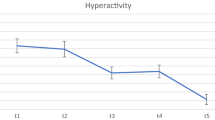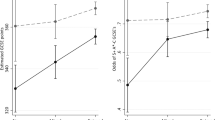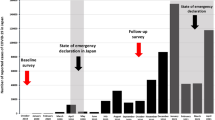Abstract
Background/Objectives:
In addition to the nutritional benefits of healthier school food, anecdotes describe improvements in children's behaviour and educational outcomes when school food or the school dining room environment is improved. This study hypothesized that a school food and dining room intervention would improve pupils’ learning-related classroom behaviour.
Subjects/Methods:
A controlled intervention trial involving six primary schools matched in triplets and randomly assigned to a 12-week intervention (promotion of healthier school food at lunchtime and changes in the school dining environment) or 12-week wait-listed control group. Study outcome was learning-related behaviours measured in a random sample of 146 pupils in years 3–5.
Results:
On-task and off-task behaviours were observed and used as proxy measures for concentration and disengagement (disruption), respectively. Teacher–pupil on-task engagement was 3.4 times more likely in the intervention schools compared with the control schools (adjusted model odds ratio (OR)=3.40 (95% confidence interval (CI)=1.56, 7.36), P=0.009). However, on-task pupil–pupil behaviour was less likely in the intervention group (adjusted model OR=0.45 (95% CI=0.28, 0.70), P<0.001). Similarly, off-task pupil–pupil behaviour was more likely in the intervention group than in the control group in both the unadjusted model (OR=2.18 (95% CI=1.52, 3.13), P<0.001) and the adjusted model (OR=2.28 (95% CI=1.25, 4.17), P=0.007).
Conclusions:
This study offers some support for the hypothesis that a school food and dining room intervention can have a positive impact on pupils’ alertness. However, if raised alertness is not channelled and supervised, it may result in increased off-task behaviour when pupils are working together.
This is a preview of subscription content, access via your institution
Access options
Subscribe to this journal
Receive 12 print issues and online access
$259.00 per year
only $21.58 per issue
Buy this article
- Purchase on Springer Link
- Instant access to full article PDF
Prices may be subject to local taxes which are calculated during checkout



Similar content being viewed by others
References
Baines E, Blatchford P, Kutnick P (2003). Changes in grouping practices over primary and secondary school. Int J Educ Res 39, 9–34.
Baines E, Blatchford P, Kutnick P (2008). Pupil grouping for learning: developing a social pedagogy of the classroom. In: Gillies R, Ashman A Terwel J (eds) The Teacher's Role in Implementing Cooperative Learning in the Classroom. Springer-Verlag: New York.
Belot M, James J (2009). Healthy School Meals and Educational Outcomes. Institute for Social and Economic Research: London.
Bennett N, Desforge C, Cockburn A, Wilkinson B (1984). The Quality of Pupil: Learning Experiences. LEA: London.
Blatchford P, Baines E, Rubie-Davies C, Bassett P, Chowne A (2006). The effect of a new approach to group work on pupil-pupil and teacher-pupil interactions. J Educ Psychol 98, 750–765.
Blatchford P, Bassett P, Brown P (2005). Teachers’ and pupils’ behaviour in large and small classes: a systematic observation study of pupils aged 10/11 years. J Educ Psychol 97, 454–467.
Dunifon R, Kowaleski-Jones L (2002). Who's in the house? Race differences in cohabitation, single parenthood, and child development. Child Dev 73, 1249–1264.
Ells LJ, Hillier FC, Shucksmith J, Crawley H, Harbige L, Shield J et al. (2008). A systematic review of the effect of dietary exposure that could be achieved through normal dietary intake on learning and performance of school-aged children of relevance to UK schools. Br J Nutr 100, 927–936.
Galton MJ, Hargreaves L, Comber C, Wall D, Pell A (1999). Inside the Primary Classroom: 20 Years On. Routledge: London.
Galton MJ, Simon B, Croll P (1980). Inside the Primary Classroom. Routledge & Kegan Paul: London.
Gietzen D, Vermeersh JA (1980). Health status and school achievement of children from Head Start and Free School Lunch Programs. Public Health Rep 95, 362–368.
Goldstein H (1995). Multilevel Statistical Models. Edward Arnold: London.
Goldstein H, Rasbash J, Plewis I, Draper D, Browne W, Yang M et al. (1998). A User's Guide to MLwiN. Multilevel Models Project. Institute of Education University of London.
Hastings N, Schweiso J (1995). Tables and tasks: the effects of seating arrangements on task engagement in primary classrooms. Educ Res 37, 279–291.
North Yorkshire Business & Education Partnership, Business & Education South Yorkshire (2004). The Dining Room Environment Project. Food in Schools Programme (DfES, DH). Available at: http://webarchive.nationalarchives.gov.uk/+/www.dh.gov.uk/en/Publichealth/Healthimprovement/Foodinschoolsprogramme/Foodinschoolsgeneralinformation/DH_4080828.
Paterson L, Goldstein H (1991). New statistical methods for analyzing social structures: an introduction to multilevel models. Br Educ Res J 17, 387–393.
School Meals Review Panel (2005). Turning the tables —transforming school food: the development and implementation of nutritional standards for school lunches. http://www.schoolfoodtrust.org.uk/UploadDocs/Library/Documents/SMRP_Report_FINAL.pdf.
SPSS Inc. Chicago (2006). SPSS for Windows, version 15.0. SPSS Inc.: Chicago.
Statutory Instrument 2000 No. 1777. Education (Nutritional Standards for School Lunches) (England) Regulations, 2000: TSO: London.
Statutory Instrument 2006 No. 2381. The Education (Nutritional Standards for School Lunches) (England) Regulations, 2006: TSO: London.
Statutory Instrument 2007 No. 2359. The Education (Nutritional Standards and Requirements for School Food) (England) Regulations, 2007: TSO: London.
Acknowledgements
We thank the staff and pupils of the Sheffield primary schools who participated in the study and all the organizations and individuals who contributed to its design and implementation: the Sheffield Healthy Schools Team, Sheffield PCT, Chartwells, Chaucer Catering, Sheffield Children and Young People's Directorate, Sheffield local authority and the National Centre for Social Research. In addition, we thank Claire Storey and Pauline Ashfield-Watt, both of the School Food Trust for their help in revising the manuscript. This study was funded by the School Food Trust.
Author information
Authors and Affiliations
Corresponding author
Ethics declarations
Competing interests
The authors declare no conflict of interest.
Rights and permissions
About this article
Cite this article
Golley, R., Baines, E., Bassett, P. et al. School lunch and learning behaviour in primary schools: an intervention study. Eur J Clin Nutr 64, 1280–1288 (2010). https://doi.org/10.1038/ejcn.2010.150
Received:
Revised:
Accepted:
Published:
Issue Date:
DOI: https://doi.org/10.1038/ejcn.2010.150
Keywords
This article is cited by
-
Effects of lunch on children’s short-term cognitive functioning: a randomized crossover study
European Journal of Clinical Nutrition (2013)



